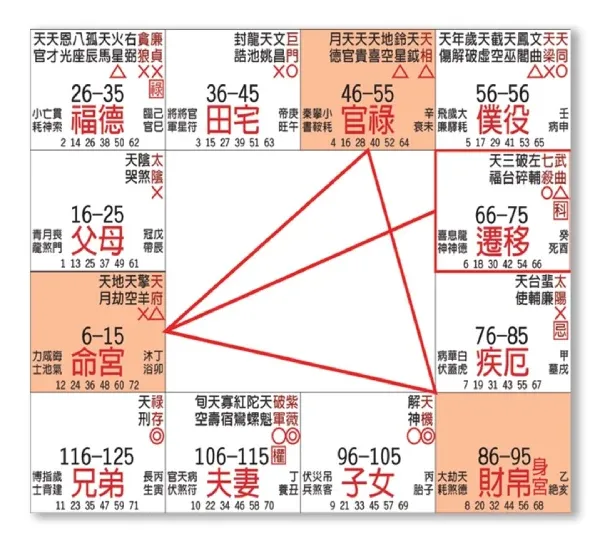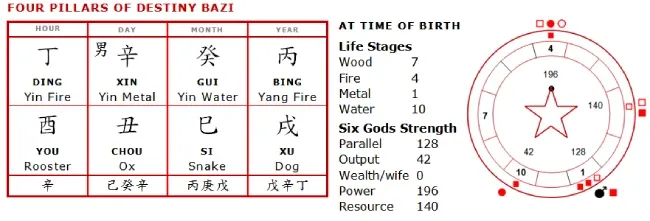Chinese Astrology and Horoscopes: Ziwei Dou Shu and The 4 Pillars of Destiny, Which is Better?
Astrology, with prehistoric roots, continues to thrive in modern times. The practice of astrology can be traced in almost every human society and most historical periods. It can be argued that predicting the future and mitigating risks are fundamental human needs across all civilizations worldwide.
Complex systems of astrology also developed in China, and they are deeply interwoven in every aspect of Chinese life.
1. Chinese methods of predicting the future
The Chinese have two types of fortune-telling systems that are based on birth data: the 4 Pillars of Destiny四柱命理學(also known as Eight Characters or Ba Zi) and Purple Star Astrology紫微斗數(also known as Zi Wei Dou Shu). Both are highly regarded as ancient systems of Chinese Astrology life map readings and are used to identify information for life, career, wealth, and destiny readings.
2. Purple Star Astrology紫微斗數(Ziwei Dou Shu)
The origin
The name Ziwei Dou Shu was first seen in the "Xudao Zang"续道藏compiled by Zhang Guoxiang张国祥, the 50th generation Zhengdao Celestial Master, in the 35th year of Wanli Emperor Shenzong of the Ming Dynasty (1607). It contains three volumes of "Zi Wei Dou Shu" and the author is unknown. Ziwei Dou Shu is considered to be improved from the "Eighteen Flying Stars" included in "Xudao Zang"续道藏.
It is believed to have been created by the ancestor of Chen Tuan陈抟(Chen Xiyi陈希夷) towards the end of the Five Dynasties period, and there is a popular saying among Chinese folk that it was passed down to Chen Xiyi by Lu Dongbin吕洞宾.
In the process of spreading, Ziwei Dou Shu was gradually divided into two branches, the North and the South.
The Northern branch's three-volume "Ziwei Dou Shu" was later included in the classic "XuDao Zang" (above-mentioned)
The four-volume "Ziwei Dou Shu" of the Southern branch was not published and circulated until the Jiajing period of the Ming Dynasty by Luo Hongxian, a geographer in Jishui, Jiangxi Province, which later became "The Complete Works of Ziwei Dou Shu"紫微斗数全集and "The Complete Book of Ziwei Dou Shu"紫微斗数全书.
Although Ziwei Doushu rose to prominence in the late Qing Dynasty, in the early days of numerology, horoscopes were dominant. With the changes of the times, Ziwei Dou Shu developed vigorously in Hong Kong and Taiwan after the 1980s, and together with the 4 Pillars of Destiny, it is known as the two most prominent branches in modern Chinese numerology.
Theory
It is said that Ziwei Dou Shu is an "Emperor's Art", just because its principles are difficult to discover.
Ziwei Dou Shu is a type of astrology and traditional Chinese numerology. It is believed that a person's horoscope at the time of their birth determines their life and destiny. Different stars have specific relationships with people's destinies, and because the stars appear in a particular order, the corresponding individuals will accept the influence of the stars in that order. By analyzing a person's birth astrology, we can determine the quality and sequence of their destiny.

The basic method of Ziwei Dou Shu's fortune-telling is to determine the location of a person's Life “Palace” (it’s like a position on the Ziwei Dou Shu chart) based on the year, month, day, and time of his or her birth. After that, fill the other eleven palaces in the Ziwei Dou Shu chart. These palaces are: "Palace of Siblings, Palace of Spouse (Palace of Marriage), Palace of Children, Palace of Wealth, Palace of Health, Palace of Travel, Palace of Friendship (Palace of Friends), Palace of Career, Palace of Property, Palace of Spiritual and Palace of Parents".
Make a Ziwei Dou Shu horoscope; then observe the combination of stars in each palace to deduce his or her innate life trajectory; Finally, through the guidance of the four stars (Hua Ke, Hua Lu, Hua Quan, and Hua Ji化科、化禄、化权、化忌), the life fortune and fortune can be deduced.
According to Ziwei Dou Shu prediction theory, a person's character determines their destiny, and their situation depends on their heart. Even when experiencing the same thing, everyone's feelings are different, and when doing the same thing, everyone's thoughts are different. Different people can say the same thing but give others different feelings. This is due to the diverse mental structures of human beings. Ziwei Dou Shu prediction combines astronomy, Feng Shui, and Zhouyi hexagrams to make predictions.
3. The 4 Pillars of Destiny四柱命理學
The Origin
The 4 Pillars of Destiny, also known as Ba Zi or Eight Characters, is a method of fortune telling that is based on the eight characters represented by the heavenly stems and earthly branches which are determined by one's date of birth. The practice is based on the "Book of Changes" and employs the theory of yin and yang as well as the five elements.
Origin Numerology originates from the Yin Yang and Five Elements theory. In ancient times, people faced many confusions and elusiveness about their future, and it was natural to try to find a way to control their destiny. Before the Han Dynasty, people only told fortunes based on the Five Elements' Nayin, which was the year's fortune. This is a crude fortune-telling method, which is the embryonic state of numerology.
It wasn't until the Han Dynasty that methods of fortune-telling based on Yin-Yang, Five Elements, Heavenly Stems, and Earthly Branches, in conjunction with the year, month, and day, began to emerge. This fortune-telling method was further developed during the Wei, Jin, Southern, and Northern Dynasties, but it wasn't fully established until the Tang Dynasty.
Li Xuzhong李虛中(761-813), a native of the Tang Dynasty, was a significant figure in the history of numerology's development. He was a censor in the imperial palace and had extensive knowledge of the theory of yin and yang and the five elements. Li Xuzhong used the stems of a person's year, month, and day of birth to form three pillars and six characters for fortune-telling. Later generations regarded him as the originator of numerology. He also authored the book on numerology, "Li Xuzhong's Book of Fate" (李虚中命书), which has been passed down to the present day.
At the end of the Five Dynasties and the beginning of the Song Dynasty, Xu Ziping徐子平further developed and perfected Li Xuzhong's fortune-telling. He added hours to the year, month, and day, and changed from three pillars and six characters to four pillars and eight characters. It is more accurate. This is a leap in the history of the development of The 4 Pillars of Destiny. At this point, The 4 Pillars of Destiny has officially entered a relatively mature and complete stage. "Yuanhai Ziping"渊海子平written by Xu Ziping徐子平is an important work on numerology.
Theory
The 4 Pillars of Destiny theory is rooted in the principles of yin and yang and the five elements, which are based on the heavenly stems and earthly branches. The Heavenly Stems and Earthly Branches were a system utilized in ancient China to document time and events. The heavenly stems have ten symbols. The earthly branches have twelve symbols (Chinese zodiac animal signs). Heavenly stems and earthly branches can be combined into sixty branches. The 4 Pillars of Destiny arrange the four pillars of a person based on the year, month, day, and hour when he or she was born, namely the year pillar, the month pillar, the day pillar, and the hour pillar. Each pillar is composed of a heavenly stem and an earthly branch.
The core of The 4 Pillars of Destiny is the five elements. The five elements include metal, wood, water, fire, and earth, each of which has its specific attributes and characteristics. There is a mutually reinforcing relationship between the five elements, that is, metal generates water, water generates wood, wood generates fire, fire generates earth, and earth generates metal. This is the relationship of mutual generation; metal restrains wood, wood restrains earth, earth restrains water, water restrains fire, and fire restrains metal. This is It's a mutually exclusive relationship. The interdependent relationship between the five elements can reflect the pros and cons and changes in a person's character, talent, fortune, wealth, health, emotions, etc.

The basic steps of The 4 Pillars of Destiny are:
- According to the year, month, day, and hour when a person was born, determine his or her four pillars and eight characters.
- According to the heavenly stems and earthly branches in the four pillars and eight characters, determine the five elements to which he or she belongs.
- Analyze his or her character, talent, fortune, wealth, health, feelings, etc. based on the mutually reinforcing relationship between the five elements.
4. Comparison
Similarities
Ziwei Dou Shu and The 4 Pillars of Destiny rely on the astronomical calendar and the concepts of Yin Yang and the Five Elements. By determining a person's year, month, day, and hour of birth, we can make predictions about their horoscope. The horoscope contains various details such as stars, gods, heaven stems, and earthly branches. By analyzing these details, we can deduce a person's personality traits, talents, fortune, wealth, health, emotions, and other aspects of their life.
Differences
Ziwei Dou Shu focuses more on analyzing a person's fortune. It predicts what opportunities and challenges a person may face at different ages and suggests ways to seize opportunities and cope with difficulties.
On the other hand, The 4 Pillars of Destiny pays more attention to analyzing a person's essential characteristics. It helps to understand what kind of personality, talents, preferences, and weaknesses a person is born with, and how to use their strengths and improve their shortcomings.
Therefore, Ziwei Dou Shu is more suitable for predicting future development directions and trends, while The 4 Pillars of Destiny is more suitable for understanding one's inner nature and potential.
Of course, this does not mean that Ziwei Dou Shu cannot analyze a person's personality characteristics, or that The 4 Pillars of Destiny cannot predict changes in a person's fortune. It's just that in these two aspects, they each have their focus and advantages. Moreover, in the actual fortune-telling process, Ziwei Dou Shu and The 4 Pillars of Destiny are often used in combination to achieve more comprehensive and accurate results. For example, when analyzing a person's marital status, you can use Ziwei Dou Shu to see at what age he or she will encounter a romantic partner or the opportunity to get married, or you can use The 4 Pillars of Destiny to see how compatible he or she is with the other half and emotional stability.
So, which one is better?
There is no absolute answer. They are a tool, a method, a perspective. They can all help us better understand ourselves and our destiny, and make more appropriate choices and decisions based on our circumstances.